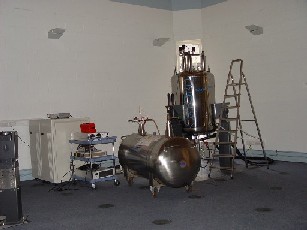|
Nuclear Magnetic Resonance (NMR) Spectroscopy is a powerful method for determining the structure of unknown organic compounds.
The nucleus (ie. protons and neutrons) within atoms can be imagined as spinning:
- If the neutrons are paired (ie. even number) and the protons are paired (ie. even number), there is zero net overall spin (eg: 12C, 16O, 32S)
- If number of neutrons + number of protons is odd, then the nucleus has half-integer spin (ie: 1/2, 3/2, 5/2) (eg: 1H, 13C, 19F and 31P have 1/2 spin.)
- If numbers of neutrons and protons are both odd, then the nucleus has integer spin (ie: 1, 2, 3) (eg: 2H, 14N)
In NMR, the most commonly measured nuclei are Hydrogen-1 (1H) and Carbon-13 (13C). This introduction will mainly consider Hydrogen-1 NMR (also called 1H-NMR, HNMR or Proton NMR). 1H is highly abundant in organic compounds, has half-integer spin, has good NMR sensitivity, and produces sharp NMR signals. In the presence of an external magnetic field, two spin states can exist, (ie: +1/2 and -1/2) which have different energies.
In Nuclear magnetic resonance (NMR) spectroscopy, a solution of the sample being investigated is placed in a strong magnetic field. Pulses of radio frequency radiation are transmitted into the sample. At specific radio frequencies, resonance of the nuclear spins will occur. The radio frequency or the strength of the magnetic field are changed over a small range, while a receiver coil is used to monitor the energy absorped, then released, due to changes between the nuclear spin states.
As electrons are charged and moving they can produce a small magnetic field opposing the applied field, so can partially shield the nuclei from the external magnetic field. Different neighbouring chemical groups will draw electrons away to differing extents, so causing different amounts of shielding, which will produce slighly different nuclear spin resonance frequencies, so the different chemical groups can be determined from the NMR recording.
As water contains much 1H, it would produce a very strong NMR signal, completely hiding any signal from the compound being investigated. So the compound is usually dissolved in heavy water (ie. D2O, where 'D' is Deuterium, 2H), or another Deuterated (Hydrogen-1 atoms replaced by Deuterium) solvent, as Deuterium, 2H, has a very different resonance frequency from 1H. A small amount of a known reference chemical may be added to the sample to give a calibration peak.
Below is a photo of a Proton NMR spectrometer at Leeds University:

600 MHz Proton Frequency NMR Spectrometer in the LC Miall building.
|